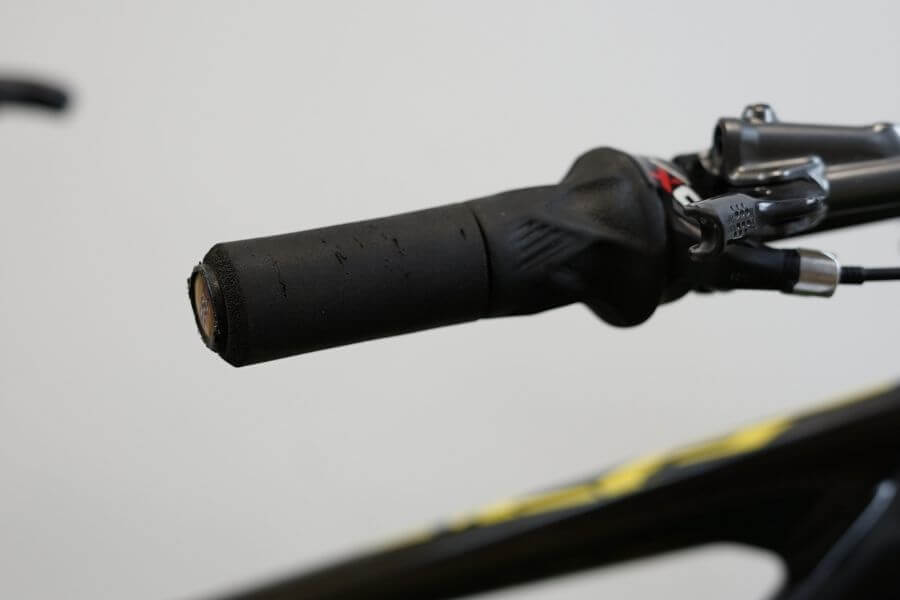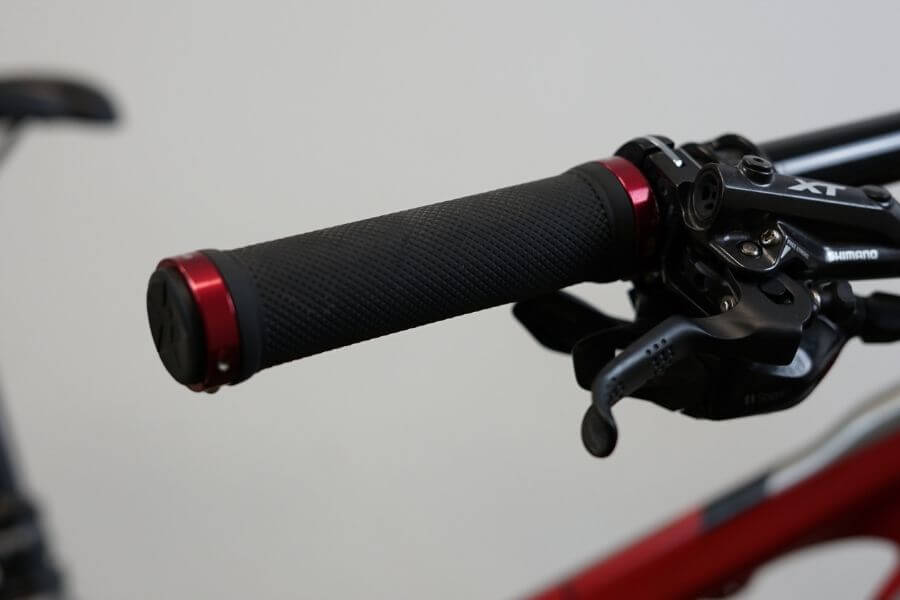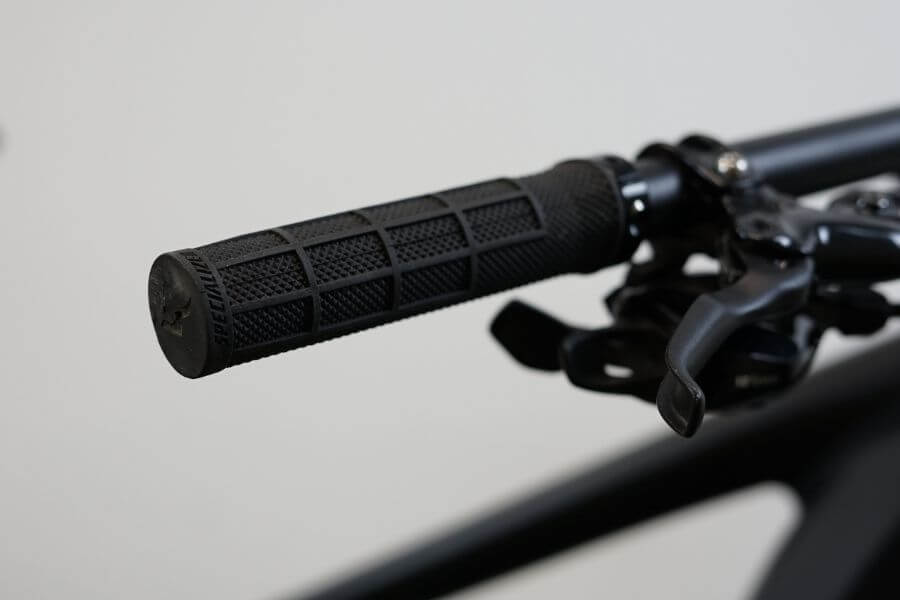The handlebars of a mountain bike constitute one of the simplest and most undervalued components. Many times they are not paying attention. We must not forget that they are a point of contact between the cyclist and the bicycle and that aspects such as its hardness, materials, size or touch influence both comfort and injury prevention. The fists must be in perfect condition, have the appropriate size and thickness and provide the necessary grip for handlebar management.
In the market there are currently two large types of fists according to its installation or adjustment: with or without closing
Lock-on. There is also a special type of fists with a specific way to delay or eliminate tiredness of hands, such as ergonomics. On the other hand, within each of these classes the fists can be manufactured in different materials to enhance qualities such as grip or lightness.
Types of fists according to your material

To start with this guide on cuffs for mountain cycling we will analyze the most used materials for fists, explaining their advantages and disadvantages.
Eraser
It provides better grip and firmness but also more weight. Enter reliefs to guarantee the adhesion of the palm of the hand and prevent them from moving.
-
Advantages: Better fixing to handlebar and hand grip. Durability.
-
Disadvantages: More weight and lower comfort.
Foam
Neoprene foam or
Foam It is used to create smooth fists or with very little relief. The advantage of using this material is lightness and comfort when grabbing the handlebars. But this material degrades more quickly than rubber and dirties more easily.
-
Advantages: Lightness and comfort.
-
Disadvantages: Lower resistance.
Silicone
We could say that it is a hybrid among rubber and foam. They provide better grip because the material is less porous than the foam, they are light and repel dirt. As for prices, foam and silicone are very similar, although they are usually somewhat more expensive.
-
Advantages: Lightness and grip.
-
Disadvantages: Higher price.
Types of fists according to their shape

Once the main materials for the manufacture of fists are described, they can be classified according to their type of fixation to the handlebar or form:
Closed fists or Lock-on
They have the part of the fist itself and one or two clamps with a screw (usually of the Allen type) at the end of the latter. Once the fist is tight when it remains fixed and without the possibility of moving. However, he adds a little more weight although its installation and withdrawal is much simpler than conventional ones, introduced under pressure.
Conventional fists
They are installed in the pressure handlebar. It is not necessary or advisable to use glue or other adhesive to fix them since their withdrawal will make it very difficult. In general, this type of fists are made with foam or silicone, although there are also rubber fists that are fixed under pressure.
Ergonomic fists
Ergonomic fists mainly serve the form. While conventional ones are circular or with small reliefs in the vast majority, ergonomics are special fists with flat sections and curves that provide a better grip and comfort to the hands. They are recommended models for
Bikers of marathon or cycling who like long cycling days. They delay the appearance of wear and dolls and are manufactured with rubber.
What cuffs choose for my bicycle?
Once the main materials and their properties and the types of cuffs for Mountain Bike existing in the market are time to guide you in your future purchase. To do this, you will have to attend three main aspects to facilitate your choice:
The material
If you are looking for a standard fist that does not contribute much weight and provide you comfort and better vibration absorption, your choice should be one of foam. If you need some more grip but without giving up comfort or lightness you should look at those of silicone. And if you want to grip and firmly those of rubber must be your fists.
Thickness
The thickness is an aspect that not everyone values when choosing some fists. And it is, however, a very important aspect in the ergonomics chapter and grip from the hand to handle. There are certain models that are offered in two or three different thicknesses. A large one will be more advisable to large hands, while one finer will adapt to a smaller or thinner. From there, personal tastes come into play: a greater thickness to absorb more vibrations, one more fine for a better grip and handling, etc.
The modality you practice
Finally, we must attend to the type of mountain cycling you perform, since there are certain more adapted fists than others to the
different modalities of Mountain Bike. For pure XC (short and explosive routes) a silicone fist is ideal, in XC Marathon the foam or ergonomics will provide an extra comfort. While in more radical modalities, such as trail or enduro, rubber fists are the favorite of the riders, and if they are
Lock-on better.
MAINTENANCE: FIXING, EXTRACTION AND CLEANING

Install and uninstall a fist can be the simplest operation of the world or the most complicated, depending on whether you have followed the manufacturer's recommendations or decided to go free. For example, if you have used an adhesive to hit your fists to the handlebar possibly, it is possible for a long time to extract them, having to inject solvent or wet the fist consciously.
That is why the most advisable thing is to set them without any glue. The fist is expressly designed to look at the handlebar. If you want an extra firmness you can wet the inside with medicinal alcohol, as well as to remove it, injected with a syringe.
For the fists with closure the installation and withdrawal is very simple, it will be enough to have an adequate key to tighten or weave the screw and the fist will quickly come out.
As for cleaning, it is very important to perform a basic cleaning after each output and one thoroughly every month. Fists usually adhere a lot of dust, dirt and sweat (if you don't use gloves), compromising grip and comfort. To clean them thoroughly we recommend extracting them and cleaning it both outside and inside, with the help of soap or a product removed.
 To start with this guide on cuffs for mountain cycling we will analyze the most used materials for fists, explaining their advantages and disadvantages.
To start with this guide on cuffs for mountain cycling we will analyze the most used materials for fists, explaining their advantages and disadvantages.
 Once the main materials for the manufacture of fists are described, they can be classified according to their type of fixation to the handlebar or form:
Once the main materials for the manufacture of fists are described, they can be classified according to their type of fixation to the handlebar or form:
 Install and uninstall a fist can be the simplest operation of the world or the most complicated, depending on whether you have followed the manufacturer's recommendations or decided to go free. For example, if you have used an adhesive to hit your fists to the handlebar possibly, it is possible for a long time to extract them, having to inject solvent or wet the fist consciously.
That is why the most advisable thing is to set them without any glue. The fist is expressly designed to look at the handlebar. If you want an extra firmness you can wet the inside with medicinal alcohol, as well as to remove it, injected with a syringe.
For the fists with closure the installation and withdrawal is very simple, it will be enough to have an adequate key to tighten or weave the screw and the fist will quickly come out.
As for cleaning, it is very important to perform a basic cleaning after each output and one thoroughly every month. Fists usually adhere a lot of dust, dirt and sweat (if you don't use gloves), compromising grip and comfort. To clean them thoroughly we recommend extracting them and cleaning it both outside and inside, with the help of soap or a product removed.
Install and uninstall a fist can be the simplest operation of the world or the most complicated, depending on whether you have followed the manufacturer's recommendations or decided to go free. For example, if you have used an adhesive to hit your fists to the handlebar possibly, it is possible for a long time to extract them, having to inject solvent or wet the fist consciously.
That is why the most advisable thing is to set them without any glue. The fist is expressly designed to look at the handlebar. If you want an extra firmness you can wet the inside with medicinal alcohol, as well as to remove it, injected with a syringe.
For the fists with closure the installation and withdrawal is very simple, it will be enough to have an adequate key to tighten or weave the screw and the fist will quickly come out.
As for cleaning, it is very important to perform a basic cleaning after each output and one thoroughly every month. Fists usually adhere a lot of dust, dirt and sweat (if you don't use gloves), compromising grip and comfort. To clean them thoroughly we recommend extracting them and cleaning it both outside and inside, with the help of soap or a product removed.












